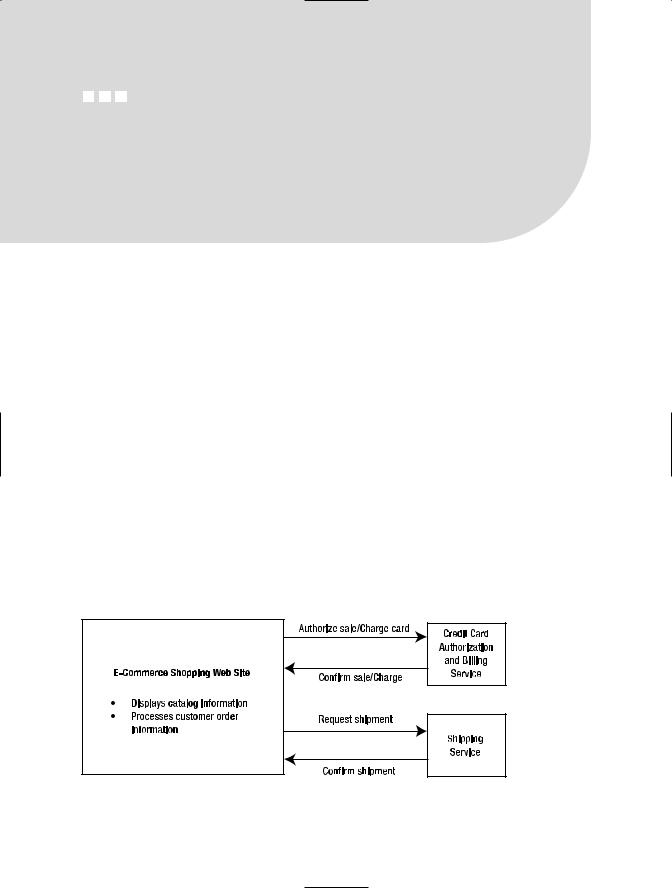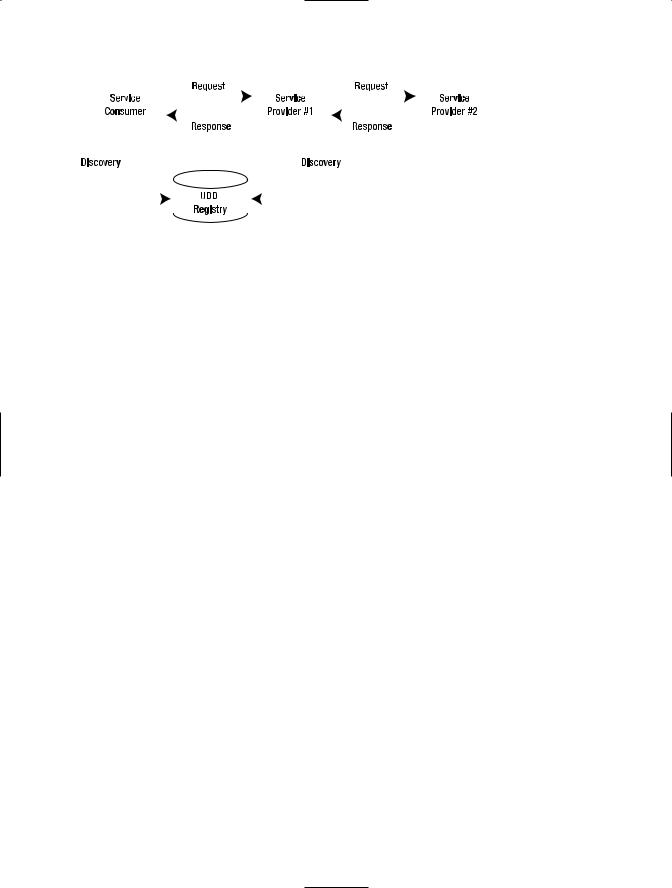
Expert Service-Oriented Architecture In CSharp 2005 (2006) [eng]
.pdf
xx ■I N T R O D U C T I O N
The summary of the chapters is as follows:
Chapter 1, Introducing Service-Oriented Architecture: This chapter introduces the concepts behind SOA and the characteristics of a Web service from the perspective of SOA. This chapter reviews the following topics:
•SOA concepts and application architecture.
•The WS-I Basic Profile.
•The WSspecifications.
•WSE 3.0 (an introduction).
Chapter 2, The Web Services Description Language: This chapter reviews the WSDL 1.1 specification and the elements of a WSDL document. This information is essential to understanding what makes up a service. The concepts that are presented here will come up repeatedly throughout the book, so make sure you read this chapter! This chapter includes the following:
•The seven elements of the WSDL document (types, message, operation, portType, binding, port, and service), which together document abstract definitions and concrete implementation details for the Web service.
•How to work with WSDL documents using Visual Studio .NET.
•How to use WSDL documents.
Chapter 3, Design Patterns for Building Message-Oriented Web Services: This chapter shows you how to build message-oriented Web services, as opposed to RPC-style Web services, which most people end up building with ASP.NET even if they do not realize it. The goal of this chapter is to help you rethink your approach to Web services design so that you can start developing the type of message-oriented Web services that fit into an SOA framework. This chapter covers the following:
•Definition of a message-oriented Web service.
•The role of XML and XSD schemas in constructing messages.
•How to build an XSD schema file using the Visual Studio .NET XML Designer.
•Detailed review of a six-step process for building and consuming a messageoriented Web service. This discussion ties into the sample solutions that accompany the chapter.
Chapter 4, Design Patterns for Building Service-Oriented Web Services: This chapter extends the discussion from Chapter 3 and shows you how to build Web services that operate within a service-oriented application. This chapter includes the following:
•A discussion on building separate type definition assemblies that are based on XSD schema files.
•How to build a business assembly for delegating service processing.

■I N T R O D U C T I O N xxi
•Detailed review of a six-step process for building and consuming a serviceoriented Web service. This discussion ties into the sample solutions that accompany the chapter.
•How to build a service agent, which is unique to SOA.
Chapter 5, Web Services Enhancements 3.0: This chapter provides a detailed overview of WSE 3.0. This chapter covers the following:
•Overview of the WSspecifications.
•Introduction to WSE 3.0—what it contains, what it does, how it integrates with ASP.NET, and how to install it.
•Overview of X.509 certificates—the WSE sample digital certificates are used frequently throughout the sample applications. Certificate installation can be difficult, so this section shows you what you need to do.
Chapter 6, Secure Web Services with WS-Security: This is the first of three chapters that provide detailed discussions on the WSE implementations of the WSspecifications. Security typically refers to two things: authentication and authorization. This chapter contains the following:
•Overview of the WS-Security specification and implementation, including the enhanced declarative model in WSE 3.0.
•Review of common security scenarios, including an overview on important security objects and concepts such as security tokens, digital signatures, and encryption.
•How to implement WS-Security using WSE 3.0 and the usernameForCertificateSecurity turnkey security assertion.
•Review of declarative vs. imperative authorization.
Chapter 7, Extended Web Services Security with WS-Security and WS-Secure Conversation: This chapter reviews how WSE 3.0 can secure other common Web service deployment scenarios. This chapter covers the following:
•Overview of the direct and brokered authentication models.
•How to implement brokered authentication using Kerberos and mutual certificates.
•How to prevent reply attacks, using time stamps, digital signatures, and message correlation.
•Overview of the WS-Secure Conversation specification, which is enhanced in WSE 3.0.
•How to implement a secure conversation between a Web service and its client, using a security token service provider.

xxii ■I N T R O D U C T I O N
Chapter 8, SOAP Messages: Addressing, Messaging, and Routing: This chapter covers several WSspecifications that work together to provide a new messaging framework for Web services. Traditional Web services are built on the HTTP request/response model. WSE 3.0 provides a messaging framework that expands the supported transport protocols to include TCP and an optimized in-process transport protocol, in addition to HTTP. These protocols are not natively tied to a request/response communications model, so you can implement alternative models, such as asynchronous messaging solutions. This chapter also reviews the WS-Addressing specification, which enables messages to store their own addressing and endpoint reference information. This chapter includes the following:
•Overview of communication models for Web services.
•Overview of the WS-Addressing specification, including a discussion of message information headers vs. endpoint references.
•Overview of how WSE implements the WS-Addressing specification.
•Overview of the WS-Messaging specification and the WSE implementation, which provides support for alternate message transport protocols and communication models.
•How to implement a TCP-based Web service using SOAP sender and receiver components.
•Overview of the WS-Routing and WS-Referral specifications, which allow messages to be redirected between multiple endpoints.
•How to build a SOAP-based router using WSE, WS-Routing, and WS-Referral.
•How to integrate MSMQ with Web services in order to implement one form of reliable messaging.
Chapter 9, Beyond WSE 3.0: Looking Ahead to Windows Communication Foundation (WCF): WCF (formerly code named Indigo) provides infrastructure and programming support for service-oriented applications. WCF will be released in late 2006 as part of the upcoming Vista operating system. It focuses on messages, providing support for creating messages, for delivering messages, and for processing messages. With WCF there is less ambiguity in your services: the infrastructure forces you to be message oriented and to work with well-qualified XML-based data types. WSE 3.0 and its future revisions will provide you with excellent preparation for working with WCF in the future. This chapter contains the following:
•Overview of WCF architecture, including the Indigo service layer, the WCF connector, hosting environments, messaging services, and system services.
•Understanding WCF Web services.
•Understanding WCF applications and infrastructure.
•How to get ready for WCF.
•WSE 3.0 and WCF.

■I N T R O D U C T I O N xxiii
Notes on the Second Edition
This book is the second edition release of Expert Service-Oriented Architecture: Using the Web Services Enhancements 2.0. Readers of the previous edition will find that about 60 percent of the material has been rewritten to cover breaking changes and new features in WSE 3.0. The five introductory chapters of this book are similar to the first edition, although all code samples and screen captures have been updated to reflect WSE 3.0 and Visual Studio 2005.
The most significant change in WSE 3.0 is in the area of security implementation, with the introduction of the turnkey security scenarios, which are natively supported, common security scenarios that can be implemented using straightforward policy declaration files. Policy files were important in WSE 2.0, but in WSE 3.0 they assume an even greater importance, to the point that in most cases you will not need to write custom code with the WSE 3.0 API. Correspondingly, the second edition of this book reduces the amount of .NET code compared to what was presented in the first edition, and instead focuses more on how to achieve your goals using declarative policy files. The exception is in the area of SOAP messaging, which allows you to build custom SOAP senders and receivers that operate over alternate protocols instead of HTTP. This area is still code-intensive compared to other functional areas that are supported by WSE 3.0.
It is important to note that the WSE 3.0 product is not a full upgrade to WSE 2.0; rather it is a complementary product that improves on certain areas (such as security implementation) while leaving other areas essentially untouched (such as SOAP messaging). The full WSE 2.0 functionality has been subsumed into the WSE 3.0 product, so you will not need to use both products. However, what this means is that you can leverage many aspects of your WSE 2.0 experience into WSE 3.0, which will prevent productivity disruption and will allow you more time to focus on important enhancements in WSE 3.0.
If you have already purchased the first edition of this book you will still find a lot of value in this second edition, particularly in Chapters 6 and 7 on security implementations, which are significantly enhanced in WSE 3.0. These chapters have been completely rewritten for this edition. If you are new to this book you will find it to be a comprehensive resource for building service-oriented Web services using the WSE 3.0 product.
Code Samples and Updates
This book is accompanied by a rich and varied set of example solutions. The sample solutions were built using the production version of WSE 3.0 that was released on November 7, 2005. The code examples are chosen to illustrate complicated concepts clearly. Although Web Services Enhancements are conceptually complicated, this does not mean that they translate into complex code. In fact, the situation is quite the opposite. You will be surprised at how clear and straightforward the code examples are, plus you will find that most WSE-supported functionality can be accessed and administered via declarative policy files that do not require you to write a single line of .NET code.
■Note The sample solutions are available for download at http://www.apress.com.

xxiv ■I N T R O D U C T I O N
Visit http://www.bluestonepartners.com/soa.aspx for updates to the book and sample solutions, and for errata corrections. Check there often, because WSE is expected to undergo several revisions between now and the release of the WCF. In addition, the topic of SOA continues to evolve rapidly, and every month brings new, interesting developments.
And now, once more into the breach, dear friends, once more . . .

C H A P T E R 1
Introducing Service-Oriented
Architecture
Service-oriented architecture (SOA) represents a new and evolving model for building distributed applications. Services are distributed components that provide well-defined interfaces that process and deliver XML messages. A service-based approach makes sense for building solutions that cross organizational, departmental, and corporate domain boundaries. A business with multiple systems and applications on different platforms can use SOA to build a loosely coupled integration solution that implements unified workflows.
Overview of Service-Oriented Architecture
The concept of services is familiar to anyone who shops online at an e-commerce web site. Once you place your order, you have to supply your credit card information, which is typically authorized and charged by an outside service vendor. Once the order has been committed, the e-commerce company coordinates with a shipping service vendor to deliver your purchase. E-commerce applications provide a perfect illustration of the need for an SOA. If the credit card billing component is offline or unresponsive, you do not want the sales order process to fail. Instead, you want the order to be collected and the billing operation to proceed at a later time. Figure 1-1 provides a conceptual workflow for an e-commerce business that uses multiple services to process orders.
Figure 1-1. Service-based workflow for an e-commerce business
1

2 C H A P T E R 1 ■ I N T R O D U C I N G S E R V I C E - O R I E N T E D A R C H I T E C T U R E
SOA is like other distributed architectures in that it enables you to build applications that use components across separate domain boundaries. SOA uses Web services as application entry points, which are conceptually equivalent to the proxy and stub components of traditional component-based distributed systems, except that the interactions between the Web service provider and the consumer are more loosely coupled.
SOA is also unique in that it incorporates those factors that are critically important to business: service reliability, message integrity, transactional integrity, and message security. In the real world, businesses cannot take a chance on services that may not successfully process a request. It is a given that disparate systems may be up or down at various times, or that systems may differ in their responsiveness due to varying loads, but none of this is an excuse for allowing service request messages to simply drop away into the void. Furthermore, there can be no ambiguity as to how a service must be called. If a system publishes its capabilities as a web-enabled service, it needs to clearly document how the service must be called.
SOA addresses many of the availability and scalability issues in today’s applications. Most applications implement a rigid synchronous communication model with a linear workflow that is highly susceptible to failures at any point. SOA assumes that errors can and will occur, so it implements strategies for handling them. For example, if a service fails to accept a message request the first time, the architecture is designed to retry the delivery. And if the service is entirely unavailable (which should never occur in a robust SOA), the architecture is designed to avoid possible catastrophic failures that may disrupt the entire service request. SOA improves reliability because temporary failure in one part of the workflow will not bring down the entire business process.
In a broader sense, SOA represents a maturing process, that is, the “growing up” of Web services and integration technologies. SOA recognizes that mission-critical systems built on distributed technology must provide certain guarantees. They must ensure that service
requests will be routed correctly, that they will be answered in a timely fashion, and that they will clearly publish their communication policies and interfaces.
In an SOA solution, the distributed application uses service components that reside in separate domains. Service components operate inside their own trust boundary and encapsulate their own data. They are maintained and updated independently of, though loosely coupled with, the applications that use them.
Figure 1-2 shows a conceptual SOA that summarizes the three main entities in a typical SOA solution:
•Service providers
•Service consumers
•Service directories
The consumer can use the Universal Discovery, Description, and Integration (UDDI) registry to discover or reference the description of a service provider. Interestingly, in Figure 1-2, Service Provider #1 references a service provider (Service Provider #2). In this role, Service Provider #1 is equivalent to a service consumer and can reference the UDDI registry for information about Service Provider #2.

|
|
|
|
|
|
|
C H A P T E R 1 ■ I N T R O D U C I N G S E R V I C E - O R I E N T E D A R C H I T E C T U R E |
3 |
||||||
|
|
|
|
|
|
|
|
|
|
|
|
|
|
|
|
|
|
|
|
|
|
|
|
|
|
|
|
|
|
|
|
|
|
|
|
|
|
|
|
|
|
|
|
|
|
|
|
|
|
|
|
|
|
|
|
|
|
|
|
|
|
|
|
|
|
|
|
|
|
|
|
|
|
|
|
|
|
|
|
|
|
|
|
|
|
|
|
|
|
|
|
|
|
|
|
|
|
|
|
|
|
|
|
|
|
|
|
|
|
|
|
|
|
|
|
|
|
|
|
Figure 1-2. Conceptual SOA solution
The communication between the services and the consumer is in the form of XML messages that are qualified according to defined XSD schemas. XML messages are discrete entities that may be transported, rerouted, and referenced at any point along the business workflow. Messages promote higher levels of reliability and scalability because they can be stored, and the services that process the messages can append additional information, which provides for a clear and unambiguous chain of custody across the business workflow. In addition, messages can be queued in the event that a service is temporarily unavailable or backlogged.
XML messages are unlike traditional remote procedure calls (RPCs), which do not provide a discrete structure for encapsulating a method “request.” Traditional RPCs cannot typically be cached or held in a queue to wait for a better time to service the request. Instead, traditional RPCs typically time out if the receiving component does not respond within the expected length of time. In addition, RPCs are not qualified to a reference schema (although they must conform to type libraries for custom data types). Here lies the first important lesson for developing SOA solutions: the Web services in the solution must be designed to be message-oriented rather than RPC-oriented. This topic is the exclusive focus of Chapter 3.
What Are Web Services, Really?
Many of us are so familiar with current Web services technology that we often do not stop to think about what services really are. However, you will need to if you are going to fully understand what makes SOA so significant. Let’s pull out four definitions that collectively describe what services are:
•Services are autonomous components that process well-defined XML messages.
•Services provide a well-defined interface that is described by an XML-based document called the Web Services Description Language (WSDL) document, otherwise known as the WSDL contract. This documents the operations (methods) that the service supports, including data type information and binding information for locating and communicating with the Web service operations.
•Services provide endpoints that consumers and other services can bind to, based on the service’s port address (typically a URL).

4 C H A P T E R 1 ■ I N T R O D U C I N G S E R V I C E - O R I E N T E D A R C H I T E C T U R E
•Services are analogous to traditional object-oriented (OO), type-based components in that they provide a defined interface and they execute one or more operations. However, a key difference is that service consumers can flexibly bind to a service, whereas OO component consumers must set more rigid references. Service consumers can respond flexibly to changes in a service provider interface because it is easy to regenerate the proxy class using the updated WSDL document. However, if a traditional component changes its interface, the consumer itself must be recompiled in order to avoid type mismatch errors. Components are tightly integrated to their consumers and can break them. Service consumers, however, do not have to recompile if their service changes. Instead, they simply have to rebind to the updated WSDL document. This is what is known as loose coupling, or loosely coupled services.
Of course, if the service drastically changes its method signatures, problems may result in the consumer. For example, the consumer may not have the ability to supply new and modified input parameters for the updated methods. But as with any kind of interface-based programming, it is understood that you cannot make significant changes to an existing method signature, especially in terms of dropping existing input parameters, or changing the type definitions for existing input or output parameters. In Web services terms, this extends to the XML schema–based input and output messages that are exchanged by the service, as well
as to its supported operations. Just as with traditional components, services should ideally remain backward-compatible as their interfaces evolve, although this is not a requirement as it is for classic OO programming. Web services technically only need to honor their current contract as documented by their WSDL document, which allows potential clients to dynamically bind to the service using the latest contract interface. Still, it is a significant advantage that service consumers are autonomous from the services that they consume. This promotes better stability in the SOA solution as the member services evolve.
There are five important properties of services in contrast to traditional type-based components:
Services are described by a WSDL contract, not by type libraries: The WSDL contract fully describes every aspect of the service, including its operations, its types, and its binding information. WSDL is fully described in Chapter 2. In this sense it is much more complete than traditional type libraries.
Service descriptions can be easily extended: The WSDL contract is based on an extensible document structure that readily incorporates additional information beyond the core service description. For example, security and policy information may be stored within the WSDL document as custom SOAP elements. In fact, all of the Web services enhancements that implement SOA infrastructure support can be documented as custom SOAP elements. At its most basic level, SOAP is a stateless, one-way messaging protocol. But it is also highly extensible, which makes it an excellent medium for storing and transporting Web service enhancement information.
Services provide a service guarantee: Traditional type definitions provide no guarantees. They are what they are, and you simply use them. But what happens if the type definition gets out of sync with the component it is supposed to describe? This happens all the time in the COM+ world, which relies on the Windows registry to store associated references

C H A P T E R 1 ■ I N T R O D U C I N G S E R V I C E - O R I E N T E D A R C H I T E C T U R E |
5 |
between registered components and their type libraries. Every developer has experienced so-called DLL Hell, in which successive installations and removals of upgraded components cause incorrect type information to be retained in the registry. Technically, this is a versioning problem. But in more general terms this example points to the fact that there is no service guarantee in the world of type libraries. You just have to hope that the component is registered with the correct type library.
Services, on the other hand, can implement a service guarantee in the form of a policy description that is contained within the WSDL contract. So-called policy assertions are published with the contract to describe what level of service the consumer can expect, and how the service operations can be expected to respond. There are many advantages to policy assertions, not the least of which is that you could implement code in your consumer so that it will only work with a service that enforces a minimum policy guarantee. Should this policy ever change, then your consumer is designed not to use the service any longer. In a very sophisticated application, you could design your consumer to autodiscover an alternate service using the UDDI registry.
Services allow for things to go wrong: When you call a method on a traditional type-based component, you are making a leap of faith that the call will execute successfully. The reality is that the vast majority of calls do go through, creating a sense of complacency that this is always the case. But in the service-oriented world, where the supporting infrastructure is vastly more intricate and decoupled, you cannot have such a high level of faith that calls will always go through. Recall that XML messages are the gold currency of service requests. Messages can experience trouble at many steps along the way. Trouble in the transport channel can prevent them from being delivered. Trouble in the service’s server or firewall can prevent the service from ever responding to a received message. Furthermore, messages may be tampered with, so that they are malformed or suspect when they do reach their intended target.
SOA accommodates all of these many potential problems using a set of technologies that maintain the integrity of a service request even if things go wrong along the way. These include reliable messaging, transaction support, and authentication mechanisms to ensure that only trusted parties are involved in the service request (including certificatebased mechanisms).
Services provide flexible binding: Services fully describe themselves using the WSDL contract. This information includes documentation of the service operations as well as data type information, referenced by well-defined XML schemas. This enables clear and unambiguous qualified references. The best part is that a consumer does not have to have any prior knowledge of a data type, as long as its XML namespace is documented by or referenced by the WSDL contract. For example, consider a consumer that calls a stock quote service. This service provides a RequestQuote method that returns a custom complex data type called Quote, which includes current and previous share price information, as well as 52-week high and low values. The consumer has no advanced knowledge of how the Quote data type is structured, but it does not need
to as long as it can reference the qualified associated XSD schema.
